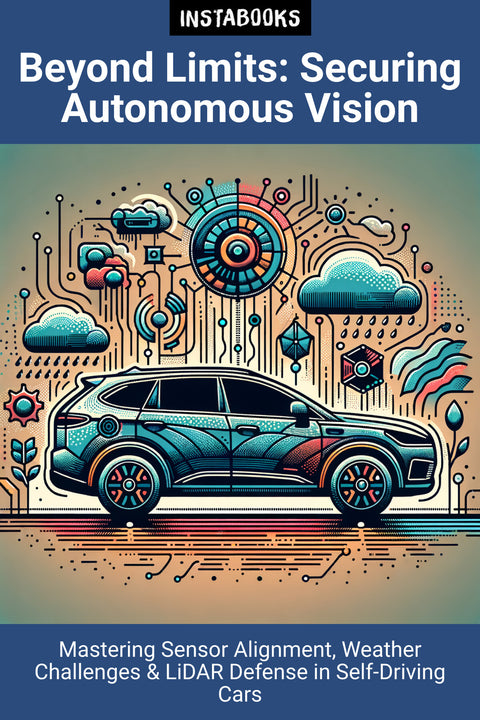
Beyond Limits: Securing Autonomous Vision
Mastering Sensor Alignment, Weather Challenges & LiDAR Defense in Self-Driving Cars
Included:
✓ 200+ Page AI-Generated Book
✓ ePub eBook File — read on Kindle & Apple Books
✓ PDF Print File (Easy Printing)
✓ Word DOCX File (Easy Editing)
✓ Hi-Res Print-Ready Book Cover (No Logo Watermark)
✓ Full Commercial Use Rights — keep 100% of royalties
✓ Publish under your own Author Name
✓ Sell on Amazon KDP, IngramSpark, Lulu, Blurb & Gumroad to millions of readers worldwide
An Insight into Autonomous Vehicle Perception
In the age of autonomous driving, achieving robust long-range perception in vehicles has become a pivotal focus for researchers and technologists alike. "Beyond Limits: Securing Autonomous Vision" is an enlightening exploration into the strategic methodologies employed to enhance sensor robustness against misalignment and to fortify defenses against spoofing attacks.
The Role of Sensor Fusion and Multi-Task Learning
The book delves into the advances in sensor fusion and multi-task learning approaches that have revolutionized our capabilities in detecting road users. These technologies counteract the vulnerabilities faced due to angular displacements in sensor placements, ensuring accurate data interpretation and vehicle safety. Rigorous research compiles insights on how calibrated uncertainties can be predicted, and misalignments can be detected and corrected effectively.
Countering Spoofing Attacks with CARLO and SVF
Another highlight is the exploration of tools like CARLO (Camera and LiDAR Odometry) and SVF (Sensor Fusion) which provide robust defenses against LiDAR spoofing. "Beyond Limits" provides a detailed look at how combining data from multiple sensors enhances environmental comprehension and mitigates spoofing effects, ensuring the autonomous systems’ consistent performance.
Adverse Weather and Cooperative Perception
Weather undoubtedly plays a significant role in perception accuracy. The book evaluates the impact of adverse conditions like rain or fog on various sensor modalities, shedding light on robust detection algorithms. Furthermore, the potential of cooperative perception systems through V2V communication to extend local sensor range and combat weather-induced challenges is thoroughly examined.
Simulated Testing and Multimodal Datasets
The final chapters focus on the importance of multimodal datasets and simulation-based evaluation. Recognizing the diversity in environmental influences, the book discusses the use of simulation tools and scenario generation to create realistic test environments, thus validating the robustness of perception algorithms in autonomous vehicles. "Beyond Limits" is more than a book—it’s a guide to understanding and innovating in the autonomous vehicle sector, offering comprehensive insights into creating vehicles that perceive and adapt like never before.
Table of Contents
1. Understanding Sensor Fusion- The Basics of Sensor Fusion
- Improving Road User Detection
- Correcting Misalignment Issues
2. Strategies Against LiDAR Spoofing
- Introduction to Spoofing Threats
- Implementing CARLO Methods
- Strengthening with SVF
3. Weather Challenges on Perception
- Weather's Impact on Sensors
- Developing Robust Detection Algorithms
- Real-World Testing and Simulations
4. Enhancing Cooperative Perception
- V2V Communication Benefits
- Extending Sensor Range
- Handling Occluded Areas
5. Multimodal Data in Autonomous Driving
- What Are Multimodal Datasets?
- Synchronizing Sensor Inputs
- Training Neural Networks Effectively
6. Simulation-Based Methodologies
- Importance of Simulation Tools
- Scenario Generation Techniques
- Evaluating Algorithm Robustness
7. Ensuring Robust Perception in All Conditions
- Comprehensive Testing Approaches
- Success Stories and Case Studies
- Future Directions in Perception
8. Integrating Advanced AI Techniques
- AI's Role in Sensor Fusion
- Machine Learning Enhancements
- Predictive Modeling Applications
9. Overcoming Technical Limitations
- Identifying Key Challenges
- Innovative Solution Pathways
- Industry Collaborations
10. The Future of Autonomous Perception
- Emerging Trends to Watch
- Technological Forecasts
- Policy and Ethical Considerations
11. Implementing Real-World Solutions
- From Research to Reality
- Adapting to Changing Environments
- Real-Life Implementations
12. Conclusion: Towards Safer Roads
- Summarizing Key Insights
- Progress Achieved So Far
- Vision for Safer Autonomous Driving
Target Audience
This book is tailored for engineers, researchers, and technology enthusiasts interested in autonomous vehicles and sensor technologies.
Key Takeaways
- Comprehensive understanding of sensor fusion and its impact on road safety.
- Key methods to combat LiDAR spoofing and sensor misalignment.
- Insights into the role of adverse weather in sensor performance and how to optimize detection.
- The importance of cooperative perception and how V2V communication extends sensor capabilities.
- An exploration of simulation tools for robust perception algorithm evaluation.
